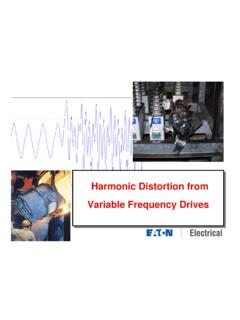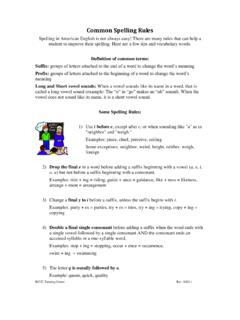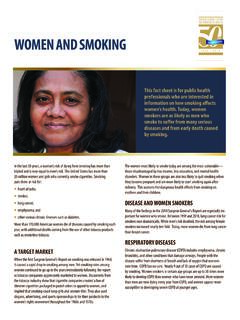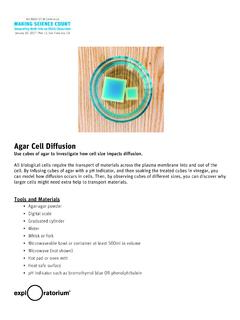Transcription of Grades K–12 - NASA
1 Educational Guide Grades Educators K 12. EG-2007-12-179-MSFC. Acknowledgements Adventures in Rocket Science is an expansion of the NASA guidebook Rockets by Deborah Shearer, Greg Vogt and Carla Rosenberg. New and additional material was written and compiled by: Vince Huegele, Marshall Space Flight Center Scientist and National Association of Rocketry (NAR) Education Chair Kristy Hill, Education Specialist for WILL Technology, NASA Marshall Space Flight Center Brenda Terry, Executive Director, Alabama Mathematics, Science and Technology Education Coalition (AMSTEC). This document was produced through The NASA Explorer Institute (NEI).
2 Funding for the development of this rocketry guidebook for Informal Education was provided by NASA Explorer Institute and directed by the Marshall Space Flight Center Academic Affairs Office 2008. i Table of Contents Adventures in Rocket Science Activity v vi How to Use this vii Adventures in Rocket Science Introduction: Flight of a Model 1 Practical 7. A Brief History of 17. Rocket History 24 Constellation Program America's Fleet of Next Generation Launch 27 31. 1. Move It!.. 32 2. Magic 35 3. Shuttle Drag 38 4. Paper 43 5. Straw 49 6. Rocket 50. 7. 3-2-1 POP!.. 58 8. Newton 62. 9. Pop Can Hero 68. 10. Rocket 74. 11.
3 Parachute Area Versus drop 77. 12. Balloon 83. 13. Water Bottle Rocket 85. 14. The Nose Cone 90 iii 15. Racing Against 95 16. The Parachuting 100 17. Egg drop 103. 18. At the drop of a 105 19. Free Fall Rocket Ball 107. 20. Altitude 109. 21. The Scale of a Model 117. 22. Rocket Motion Video 120. 23. Rocket Parachute Flight Duration 123. 24. Predicting and Measuring Rocket Parachute Drift 126. 25. Project 128. Glossary .. 143. Appendix A Assembly 145 Appendix B Rocket Safety 155 Appendix C Rocket 159 Appendix D Rocketry Resource 165 iv Adventures in Rocket Science Activity Matrix Page Number Acceleration Grade Level Groups Activity Velocity Altitude 1-3 4-6 7-9 10-12.
4 1 Move It! (balloon direction) X 32. 2 Magic Marbles X 35. 3 Shuttle Drag Parachute X 38. 4 Paper Rockets X X 43. 5 Straw Rockets X 49. 6 Rocket Racer X 50. 7 3-2-1 POP! X X X 58. 8 Newton Car X 62. 9 Pop Can Hero Engine 68. 10 Rocket Transportation X 74. 11 Parachute Area Versus drop Time X 77. 12 Balloon Staging X 83. 13 Water Bottle Rocket Assembly X X X 85. 14 The Nose Cone Experts X 90. 15 Racing Against Friction X 95. 16 The Parachuting Egg X 100. 17 Egg drop Lander 103. 18 At the drop of a Ball X X 105. 19 Free Fall Rocket Ball drop X 107. 20 Altitude Tracking X 109. 21 The Scale of a Model Rocket X X 117. 22 Rocket Motion Video Studies X 120.
5 23 Predicting and Measuring Rocket Parachute Drift Rate 123. 24 Rocket Parachute Flight Duration X 126. 25 Project Enterprise (2 weeks) X X X 128. Legend: X : Denotes the primary target word focus (altitude, velocity and/or acceleration). : Denotes secondary target word. : Denotes suggested grade level. v Standards Science Standard Change, Consistency and Measurement Understanding Science and Technology Properties of Objects and Materials Evidence, Models and Explanation Unifying Concepts and Processes Abilities of Technological Design Position and Motion of Objects Science and Technology Science as Inquiry Physical Science Activity Move It!
6 (balloon direction) X X X. Magic Marbles X X X X X X. Shuttle Drag Parachute X X X X. Paper Rockets X X X X X X X X. Straw Rockets X X X X X X X X. Rocket Racer X X X X X X. 3-2-1 POP! X X X X X. Newton Car X X X X X X. Pop Can Hero Engine X X X X X X X. Rocket Transportation X X X X X. Parachute Area Versus drop Time X X X X X X X X X. Balloon Staging X X X X X. Water Bottle Rocket Assembly X X X X. The Nose Cone Experts X X X X X. Racing Against Friction X X X X X X. The Parachuting Egg X X X X X X X X. Egg drop Lander X X X X X X X X. At the drop of a Ball X X X. Free Fall Rocket Ball drop X X X. Altitude Tracking X X X X X.
7 The Scale of a Model Rocket X X X X X X. Rocket Motion Video Studies X X X X X X X X. Predicting and Measuring Rocket Parachute Drift Rate X X X X X X. Rocket Parachute Flight Duration X X X X X X. Project Enterprise (2 weeks) X X X X X. vi How to Use This Guide Acknowledgements Examine the matrix for a grade level band The excitement and thrill from experiencing ( , Grades 1 3). Select a target word the launch of rocket-powered vehicles ignites located in that grade level band ( , engagement and imagination in children as velocity). The activity, Move It! will address well as adults. Constructing and launching the concept of velocity.
8 Activities are model rockets certainly provided a charge included within each grade level band to of excitement among a group of National address the three target concepts. Some Aeronautics and Space Administration (NASA) activities can be used to address multiple and higher education professionals as they target words. The length of time for each planned an Exploration Systems Mission activity is approximately one or two hours Directorate (ESMD) sponsored K-12 rocketry with the exception of the Project Enterprise curriculum and mentor/coach workshop. activity which can take up to two weeks to complete. This guide was prepared as a tool useful for informal education venues (4-H, Boys The guide includes a compilation of NASA- and Girls Clubs, Boy Scouts, Girl Scouts, developed and originally developed activities etc.)
9 , science clubs and related programs, that emphasize hands-on involvement, and can be adopted for formal education prediction, data collection and interpretation, settings. An exciting and productive study in teamwork, and problem solving. Project rocket science can be implemented using the background and an edited, student-friendly selected activities for the above-mentioned version of The History of Rocketry is settings. The guide's activities can be included. The guide includes an appendix correlated to meet formal education's core with construction directions for various curriculum objectives or used for ancillary project activities, safety guidelines and a enrichment and extension activities.
10 Glossary of terms. The series of activities in this guide require basic, inexpensive materials. They demonstrate fundamental principles of rocket science. The activities were selected and organized around the target concepts of altitude, velocity and acceleration ( , height, distance and speed). The Adventures in Rocket Science Activity Matrix on page v organizes the activities by suggested grade level bands as well as target concepts. vii Adventures in Rocket Science Introduction: Flight of a Model Rocket Guidebook Background of the scientific process and the engineering The NASA Explorers Institute (NEI) funded the applications of real world challenges.















